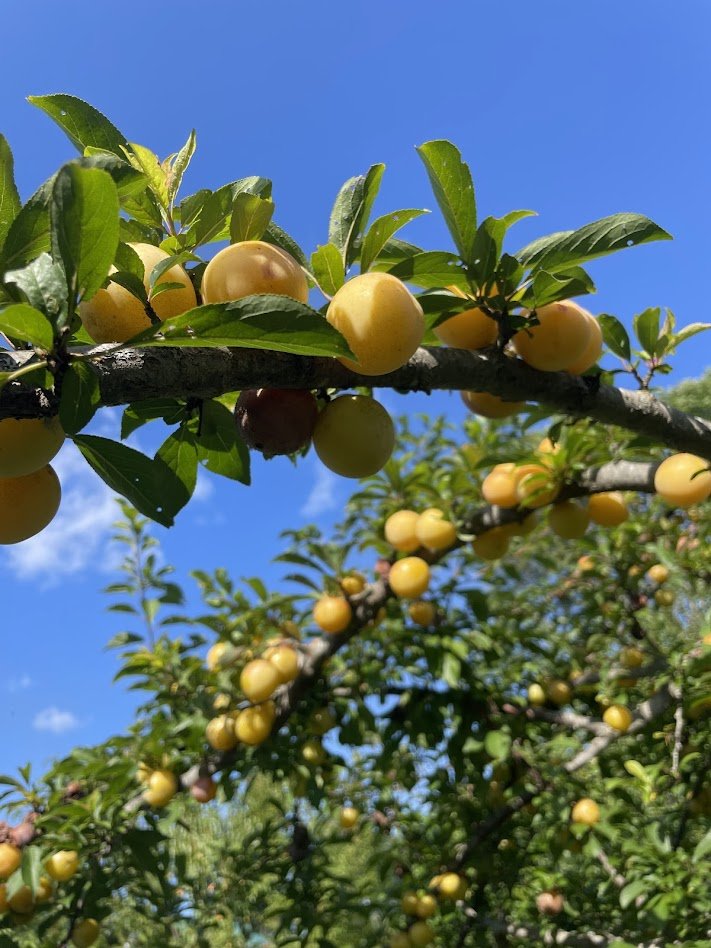
Planting Instructions
How to Plant a Tree
Following these instructions for our trees will give them the best possible chance of having a long, healthy life. There is a science to this process - proper planting helps ensure the tree will be structurally stable, minimizes transplanting shock, and keeps the root ball intact and healthy. The smoother the planting goes, the faster your tree will get established and start producing fruit too, so it’s worth taking the time to do it well.
What you’ll need:
A spade and shovel: A spade is better for scraping a layer of turf from your planting spot, digging deep around the edges of the hole, and severing any existing roots in your planting spots. A shovel will be more helpful for removing the dirt from the hole. If you only have one, you can make it work!
A tarp or sack: We like to put something like this down to put the excavated soil on, making it easier to backfill the hole once the tree is in. If you’re planting in a grassy area, the soil tends to disperse back into the ground.
Box cutter/utility knife: Since our trees are grown in fabric, air-pruning bags, the easiest way to extract them is to cut this bag right down the seam.
Water source: You’ll want to water your tree in right after planting, so make sure you have a hose or buckets of water ready to go.
Hardware cloth or tree tube or wire mesh or something similar: You’ll need something to protect the tree from getting girdled by rodents and other creatures. We usually use flexible wire mesh (wrapped around the first couple feet of the tree trunk) or 4ft. tall 1/4 in. hardware cloth set up in a cage around the tree for protection.
Measuring tape: If you’re planting more than one tree in the same area, you may want a measuring tape to ensure that you have the proper spacing. See our FAQ page for more info on the minimum distance between trees.
Step-by-Step Instructions
1. Prepare the site.
Dig the hole 2x as wide as the bag that the tree is in.
For the depth, make sure the final soil level will be flush with the soil level in the bag. This is important - the tree should not be any deeper or any higher than its current level. Planting a tree too deep can cause crown rot, which is fatal.
Make sure the sides of your hole aren’t too smooth - especially if you have clay soil. Sometimes roots will have a harder time getting established if they have to break through a smooth, hard clay wall. Score the side with your shovel or spade to rough it up a bit.
Put down a tarp or sack to put your excavated soil on. This will make it a little easier to backfill, especially if you have grass around since the soil will disperse back into the ground.
2. Lower the entire root ball into the hole carefully. Check that it’s more or less plumb (straight up and down)
3. Remove the plant from bag.
Our fruit trees are grown in fabric air-pruning bags. To get them out, grab a utility knife/box-cutter, and cut the bag down the seam.
Then, you should be able to peel the fabric bag downward off the root ball. Unlike other containerized plants, you DO NOT need to scruff up the roots.
4. Fill in the hole with the soil you excavated. It’s best to use the native soil that was already there.
Do not add compost to the hole. Doing so will encourage the roots to stay in that little hole, rather than spreading into the wide world, which leads to a more physically stable tree. Compost, mulch, and soil amendments are great, but they’ll go on top of the ground, so they can filter downward into the soil.
5. Once you’ve backfilled the hole, water the tree thoroughly.
Now, you can add compost and/or mulch around the tree. Make sure it’s not right up against the tree’s trunk, as this can cause rotting and fungal issues. We often use compost, wood chips, comfrey leaves, and alder foliage as mulch to feed the tree. You can’t go wrong with a little mulch, which adds nutrients to the soil and helps retain moisture.
You could also consider getting your soil tested to check if you need pH adjustments or if you need to add specific nutrients, depending on your site. The University of Maine’s Cooperative Extension has pretty affordable soil testing available.
6. Protect the tree from creatures. We typically use 4 ft. tall ¼” hardware cloth to create a little circular cage around the newly planted tree.
Some form of protection like this is crucial to prevent voles and deer from girdling the tree. This is when the cambium layer is nibbled in a complete circle around the tree, preventing it from getting any water or food from the roots. A little browsing of branches by the deer is okay, but the tree will die if it gets girdled, so please protect the trunk!
